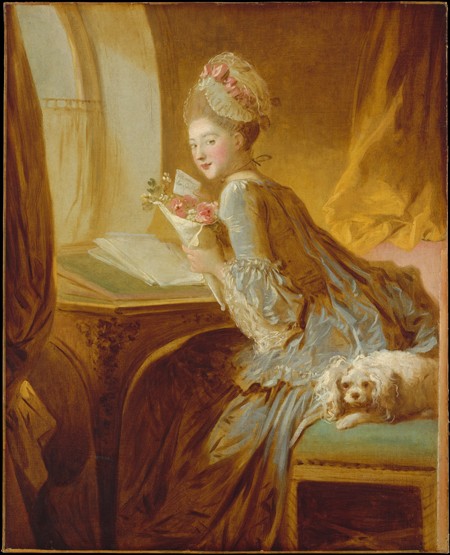The vogue for pictures featuring women penning and, more typically, perusing love letters may be interpreted as an outgrowth not merely of the age of the epistolary novel but also of what one commentator dubbed “the papered century.” The phrase encapsulates the disorienting effect of proliferating forms of monetary instruments, from stock certificates to credit and debit notes. It specifically evokes the chaos of 1720 unleashed by the bubbles. Both ventures involved the use of state-sponsored notes by members of a mass public who had been cajoled into believing in the essentially fictive value of
Eighteenth-century conceptions of romantic life as implicated in an economy of risk—famously explored by Pierre Choderlos de Laclos (1741–1803) in his Dangerous Liaisons—may be traced to 1720. That year, Bernard Picart (1673–1733) produced a print lampooning the folly that permitted fortunes to evaporate. It features the nude goddess Fortuna haloed by contracts, stock certificates, and bubbles of air. The work illustrates the dawning of an economic universe premised on nothing more substantial than credit and sustained only by a willingness to endow mysterious financial instruments with imaginary value. Strikingly, Picart produced a second version featuring a dramatic interaction between a young woman and an aged male. The former is shown resigned to the advances of the latter, who kisses her hand while bribing her with a promissory note as well as a contract for South Sea Company shares. Picart evidently saw fit to complete his image of mass hoodwinking with a scene of malevolent seduction. In so modifying his print, he not only underscored the riskiness of amorous and business relations alike; he also exhibited a conception of the two as intimately intertwined in the modern world.
A similar point may be made of a painting produced fifty years later: Fragonard’s The Love Letter. The coy expression worn by Fragonard’s pretty protagonist, seated before a stack of love letters, suggests that she is as risky an investment as Picart’s Fortuna and that her absent lover will fall victim to the very disillusionment suffered by the guileless stockholder. Along with legions of works featuring the epistolary theme—beginning with prints satirizing the disasters of 1720 under the sign of female duplicity—the painting suggests that bestowing emotional trust through the medium of letters is akin to investing one’s financial hopes
I contend that epistolary pictures marked the coming to grips with itself of a society consigned to belief in promissory notes. The genre’s ascendancy coincided with the expansion of credit and, more specifically, of social trust (
Members' Research Report Archive
Love, Trust, and Risk: Painting the "Papered Century"
Nina L. Dubin,
Samuel H. Kress Senior Fellow, 2013–2014
“We had it. He stole it. Learning to believe again in a post-Madoff world.” With some adjustments, the 2009 headline—from a Condé Nast Portfolio cover story on trust—would likely have appealed to members of a mass audience who similarly felt defrauded, nearly three hundred years earlier, of both their wealth and their willingness to believe: those victimized by the South Sea and Mississippi bubbles of 1720. The parallel bears further fruit given the emergence in the eighteenth century of a body of works of art that compelled reflection on the theme of trust in the aftermath of the financial catastrophes: namely, French epistolary pictures. Encompassing canvases by the likes of Jean-Baptiste-Siméon Chardin (1699–1779), François Boucher (1703–1770), and Jean-Honoré Fragonard (1732–1806); prints including revolutionary-era fashion plates by Philibert-Louis Debucourt (1765–1832); and hundreds of works by lesser-known artists, the genre remained the object of a veritable cult over the course of the century.

Jean-Honoré Fragonard, The Love Letter, c. 1770. Metropolitan Museum of Art, New York, The Jules Bache Collection, 1949